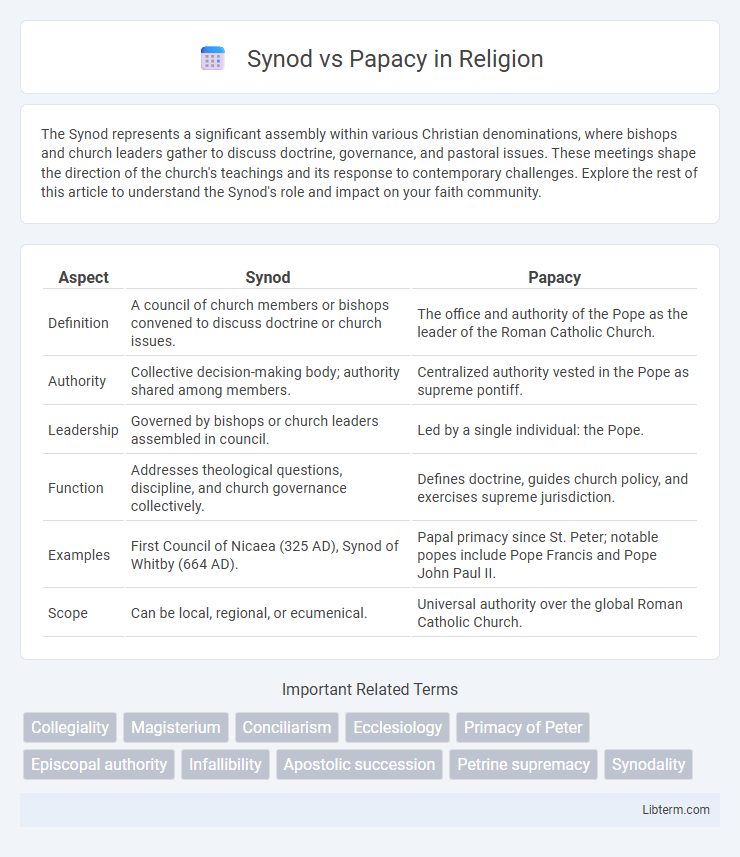The Synod represents a significant assembly within various Christian denominations, where bishops and church leaders gather to discuss doctrine, governance, and pastoral issues. These meetings shape the direction of the church's teachings and its response to contemporary challenges. Explore the rest of this article to understand the Synod's role and impact on your faith community.
Table of Comparison
| Aspect | Synod | Papacy |
|---|---|---|
| Definition | A council of church members or bishops convened to discuss doctrine or church issues. | The office and authority of the Pope as the leader of the Roman Catholic Church. |
| Authority | Collective decision-making body; authority shared among members. | Centralized authority vested in the Pope as supreme pontiff. |
| Leadership | Governed by bishops or church leaders assembled in council. | Led by a single individual: the Pope. |
| Function | Addresses theological questions, discipline, and church governance collectively. | Defines doctrine, guides church policy, and exercises supreme jurisdiction. |
| Examples | First Council of Nicaea (325 AD), Synod of Whitby (664 AD). | Papal primacy since St. Peter; notable popes include Pope Francis and Pope John Paul II. |
| Scope | Can be local, regional, or ecumenical. | Universal authority over the global Roman Catholic Church. |
Overview of the Synod and Papacy
The Synod represents a collective decision-making body within the Church, comprising bishops and other church leaders who gather to discuss doctrinal and administrative matters. The Papacy, centered on the Pope, embodies the highest spiritual authority and governance in the Roman Catholic Church, symbolizing unity and continuity. While the Synod emphasizes collaborative deliberation, the Papacy holds supreme jurisdiction and authoritative teachings.
Historical Development of Church Governance
The historical development of church governance reveals a dynamic tension between synodical authority and papal supremacy, with early Christian communities initially governed by councils and regional synods reflecting collegial decision-making. Over time, especially from the fourth century onward, the papacy consolidated power as bishops of Rome claimed primacy rooted in apostolic succession and doctrinal unity, culminating in the centralization of authority during the medieval period. This evolution shaped the trajectory of ecclesiastical structure, influencing major schisms and reforms by balancing communal synodal input against the authoritative role of the pope.
Key Differences Between Synod and Papacy
Synods are assemblies of bishops or church leaders that collectively discuss and decide on ecclesiastical matters, emphasizing conciliar governance and regional authority within the Church. The Papacy refers to the office and jurisdiction of the Pope, who holds supreme, centralized authority as the spiritual leader of the Roman Catholic Church. Key differences include decision-making processes--synods operate through communal deliberation, while the Papacy enforces hierarchical, singular leadership--and scope of influence, with synods often addressing local or doctrinal issues and the Papacy asserting universal doctrinal and pastoral authority.
Theological Foundations of the Synod
The theological foundations of the synod emphasize collegiality and the shared responsibility of bishops in governing the Church, rooted in Scriptural principles and the early Church's practice of communal discernment. Synods reflect the ecclesiology of communion, where the Holy Spirit guides the collective body rather than a single hierarchical figure, contrasting with the papacy's focus on papal primacy and infallibility as defined by Catholic dogma. This framework underscores a model of Church governance that balances authority and synodality, promoting unity without centralization.
Theological Basis of the Papacy
The theological basis of the Papacy is rooted in the belief that the Apostle Peter was granted a unique primacy by Christ, serving as the foundational rock upon which the Church is built, with the Pope considered Peter's direct successor. This primacy is supported by scriptural interpretations of passages such as Matthew 16:18-19, where Jesus gives Peter the "keys of the kingdom," symbolizing authority and governance. The Papacy emphasizes hierarchical authority and divine institution, contrasting with the Synod model that advocates collegial governance and shared decision-making among bishops.
Decision-Making Processes: Synod vs Papacy
Synod decision-making involves collective deliberation among bishops, emphasizing collegiality and shared responsibility in defining Church teachings and policies. In contrast, papacy centralizes authority in the Pope, who exercises supreme, unilateral decision-making power guided by doctrines of papal primacy and infallibility. The synod approach fosters consensus-building within episcopal assemblies, whereas the papal model prioritizes hierarchical leadership and authoritative pronouncements.
Authority and Leadership Structures
Synod authority emphasizes collective decision-making, with bishops collaborating in councils to guide church doctrine and governance. Papacy centers on a hierarchical structure, granting the pope supreme authority as the singular spiritual leader and final arbiter in doctrinal matters. This contrast highlights synodal leadership's emphasis on collegiality versus papal leadership's focus on centralized, monarchical authority.
Recent Debates and Reforms
Recent debates on Synod vs Papacy emphasize a shift toward synodality in the Catholic Church, highlighting Pope Francis' reforms that promote collective decision-making and greater involvement of bishops and laity. Documents like "Querida Amazonia" and the Synod on Synodality exemplify efforts to balance papal authority with synodal processes, fostering dialogue and decentralization. These reforms aim to address challenges in church governance while maintaining the pope's primacy within a more collaborative framework.
Impact on the Global Catholic Church
The Synod emphasizes collegial governance and laity involvement, fostering diverse theological perspectives within the global Catholic Church. The Papacy centralizes authority, ensuring doctrinal unity and consistent leadership worldwide. This dynamic shapes the Church's ability to address contemporary challenges while maintaining institutional cohesion.
Future Prospects for Synodal and Papal Authority
Future prospects for synodal authority emphasize increased collaboration and decentralization within the Catholic Church, fostering greater lay participation and episcopal collegiality. Papal authority is expected to maintain its doctrinal primacy but may evolve to accommodate diverse cultural contexts and enhance transparency in governance. The dynamic balance between synodality and papal primacy aims to strengthen the Church's adaptability and unity amid contemporary challenges.
Synod Infographic

 libterm.com
libterm.com